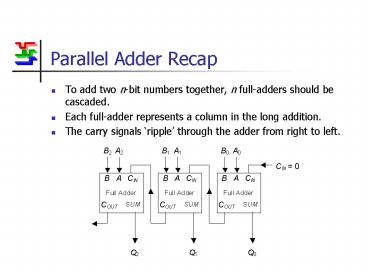Parallel Adder Recap - PowerPoint PPT Presentation
1 / 17
Title:
Parallel Adder Recap
Description:
Parallel Adder Recap. To add two n-bit numbers together, n full-adders should be cascaded. Each full-adder represents a column in the long addition. ... – PowerPoint PPT presentation
Number of Views:182
Avg rating:3.0/5.0
Title: Parallel Adder Recap
1
Parallel Adder Recap
- To add two n-bit numbers together, n full-adders
should be cascaded. - Each full-adder represents a column in the long
addition. - The carry signals ripple through the adder from
right to left.
2
Propagation Delay
- All logic gates take a non-zero time delay to
respond to a change in input. - This is the propagation delay of the gate,
typically measured in tens of nanoseconds.
1 0
X
Y
X
1 0
Y
time
3
Carry Ripple
- A and B inputs change, corresponding changes to
CIN inputs ripple through the circuit.
B
A
B
A
B
A
1
1
0
0
2
2
C
0
IN
B
A
C
B
A
C
B
A
C
IN
IN
IN
Full Adder
Full Adder
Full Adder
C
C
C
SUM
SUM
SUM
OUT
OUT
OUT
Q
Q
Q
1
0
2
4
Carry-Look-Ahead
- The accumulated delay in large parallel adders
can be prohibitively large. - Example 16 bits using 30 ns full-adders
- Solution Generate the carry-input signals
directly from the A and B inputs rather than
using the ripple arrangement.
5
Designing a Carry-Look-Ahead Circuit
B2 A2
B1 A1
B0 A0
CIN
Carry-look-ahead logic
Q2
Q1
Q0
6
Practical Carry-Look-Ahead Adder
- The complexity of each CIN term increases with
each stage. - To limit the number of gates required, a
compromise between carry-look-ahead and ripple
carry is often used. - Example 8-bit adder using two four bit adders
with carry-look-ahead.
7
Overflow
- What happens when an N-bit adder adds two numbers
whose sum is greater than or equal to 2N ? - Answer Overflow.
- Example 64 using a three-bit adder.
(6)10 (110)2 and (4)10 (100)2
8
Modulo-2N Arithmetic
- In fact, the addition is correct if you are using
modulo-2N arithmetic. - This means the output is the remainder from
dividing the actual answer by 2N. - An N-bit adder automatically uses modulo-2N
arithmetic. - Example 3-bits -gt modulo-8 arithmetic
9
Using Modulo-2N Arithmetic
Conventional arithmetic
-
0
1
2
3
4
5
6
7
Subtracting 2 is equivalent to adding
6 Subtracting x is equivalent to adding 8-x
10
Twos Complement
- Using N bits, subtracting x is equivalent to
adding 2N-x. - This implies that the number x should be
represented as 2N-x. - NB. To avoid ambiguity, when using signed binary
numbers, the range of possible values is - 3 bit example
Binary Digits 000 001 010 011 100 101 110 111
Unsigned Decimal 0 1 2 3 4 5 6 7
Signed Decimal 0 1 2 3 -4 -3 -2 -1
11
Signed Arithmetic
- Binary arithmetic rules are exactly the same.
- Now, however, overflow occurs when the answer is
bigger than 3 or less than -4
000
111
Example 3 - 1
0
-1
(3)10 (011)2 (-1)10 (111)2
110
001
-2
1
-
2
-3
010
101
3
-4
011
100
12
Signed and Unsigned Numbers
- All arithmetic operations can be performed in the
same way regardless of whether the inputs are
signed or unsigned. - You must know whether a number is signed or
unsigned to make sense of the answer.
13
Twos Complement Conversion
- A quick way of converting x to 2N-x is to
complement all the bits and add one. - Why does this work ?
Eg. N 8 and x (45)10 (00101101)2
14
A Binary Subtraction Circuit
To calculate A-B, all the bits in B must be
complemented and an extra one added using CIN
15
Comparison
- Whenever the result of an addition passes zero, a
COUT signal is generated. - This can be used to compare unsigned numbers.
COUT generated
0
7
6
1
2
5
3
4
16
Zero Flag
- NORing the result bits together tests whether all
the bits are low i.e. the result is zero. - The resulting signal (or flag) is high only when
A B.
17
Summary
- Carry-Look-Ahead
- The speed of the parallel adder can be greatly
improved using carry-look ahead logic. - Subtraction
- An adder can be simply modified to perform
subtraction and/or comparison. - Next Time
- Circuits that can either add or subtract and
more.































